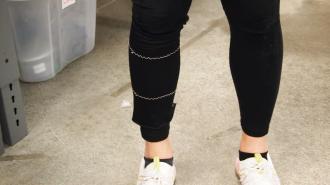The first wearable to monitor muscle atrophy could help astronauts stay strong during long space missions — and maybe help you track your own muscle mass here on Earth.
The challenge: Exposure to microgravity can cause muscle atrophy, meaning astronauts’ muscles become weaker and deteriorate — a spaceflight as short as 5 to 11 days can cause an astronaut to lose up to 20% of their muscle mass, according to NASA.
Astronauts have to exercise for 2 or more hours every day on the ISS to minimize muscle atrophy, but they only know how much muscle they’ve lost during a mission after they get back to Earth and undergo an MRI scan.
A spaceflight as short as 5 to 11 days can cause an astronaut to lose up to 20% of their muscle mass.
NASA plans to start sending astronauts on long-duration missions to the moon and eventually Mars, but it lacks a good way to monitor them for muscle atrophy during these deep trips. If it had one, it could alert an astronaut that they need to ramp up their exercise regimen while in space.
The idea: Backed by NASA funding, researchers at Ohio State University have now developed the first wearable designed to detect and monitor muscle atrophy.
The device looks like a blood pressure cuff. Two loops of electrically conductive threads are sewn into it in a zig-zag pattern that allows them to stretch and contract in response to the size of a wearer’s calf muscle.
“When we first proposed the sensor, we didn’t realize that we would need a stretchable material until we realized that the person’s limbs were going to be changing,” said lead author Allyanna Rice. “We need a sensor that can change and flex, but it also needs to be conformal.”
The wearable can measure both small changes and overall volume reductions of up to to 51%.
The team calls the loops of thread the “transmit” and “receive” coils, and to use the device, it applies a current to the transmit coil.
“[This] generates a magnetic flux on the transmit coil,” Rice told Freethink. “A magnetic flux is then induced on the receive coil, and this flux induces a voltage on the receive coil that we can measure.”
“As the circumference of the limb increases, the overall magnetic flux and voltage on the receive coil will increase as well,” she adds.
To validate the device, the OSU team 3D-printed a mold of a leg and filled it with ground beef to simulate human muscle tissue. Based on their testing, they say the wearable can measure both small changes and overall volume reductions of up to to 51%.
Looking ahead: The researchers believe their device could be useful to people on Earth as well as astronauts — rather than relying on the occasional costly MRI, patients at risk of muscle atrophy could wear the device to continuously monitor their muscle volume.
Getting to clinical trials from this proof-of-concept study will require significant work, though.
“We will continue developing this device by adding more coils to improve accuracy and resolution, using anatomical simulation and experimental models, accounting for other physiological conditions that may affect muscle volume, and elimination of bulky benchtop measurement equipment to make the sensor completely wearable,” Rice told Freethink.
Beyond monitoring: In addition to projects to monitor muscle atrophy in space, NASA is also exploring new ways to prevent it altogether — a 2020 study found that blocking a protein that regulates muscle mass actually caused mice to gain muscle during a 33-day-long trip to the ISS.
While those mice had been genetically engineered, it’s possible that medications could be used to block the protein, potentially giving astronauts a way to prevent the loss of muscle in space without hours of exercise.
We’d love to hear from you! If you have a comment about this article or if you have a tip for a future Freethink story, please email us at tips@freethink.com.
